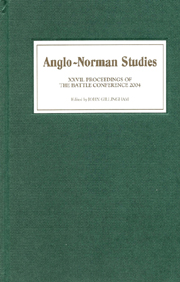Book contents
- Frontmatter
- Contents
- LIST OF ILLUSTRATIONS
- EDITOR'S PREFACE
- ABBREVIATIONS
- Probing the Passions of a Norman on Crusade: the Gesta Francorum et aliorum Hierosolimitanorum
- Gilbert Foliot et l'Ecriture, un exégète en politique
- Writing Warfare, Lordship and History: the Gesta Consulum Andegavorum's Account of the Battle of Alençon
- Anglo-French Peace Conferences in the Twelfth Century
- Peter of Blois and the Problem of the ‘Court’ in the Late Twelfth Century
- Normandy and Norman Identity in Southern Italian Chronicles
- Monastic Chronicles in the Twelfth-Century Abruzzi
- The Impact of Rebellion on Little Domesday
- Setting Things Straight: Law, Justice and Ethics in the Orationes of Lawrence of Durham
- The Angevin Kings and Canon Law: Episcopal Elections and the Loss of Normandy
- Zooarchaeology of the Norman Conquest
- Was Thomas Becket Chaste? Understanding Episodes in the Becket Lives
Zooarchaeology of the Norman Conquest
Published online by Cambridge University Press: 12 September 2012
- Frontmatter
- Contents
- LIST OF ILLUSTRATIONS
- EDITOR'S PREFACE
- ABBREVIATIONS
- Probing the Passions of a Norman on Crusade: the Gesta Francorum et aliorum Hierosolimitanorum
- Gilbert Foliot et l'Ecriture, un exégète en politique
- Writing Warfare, Lordship and History: the Gesta Consulum Andegavorum's Account of the Battle of Alençon
- Anglo-French Peace Conferences in the Twelfth Century
- Peter of Blois and the Problem of the ‘Court’ in the Late Twelfth Century
- Normandy and Norman Identity in Southern Italian Chronicles
- Monastic Chronicles in the Twelfth-Century Abruzzi
- The Impact of Rebellion on Little Domesday
- Setting Things Straight: Law, Justice and Ethics in the Orationes of Lawrence of Durham
- The Angevin Kings and Canon Law: Episcopal Elections and the Loss of Normandy
- Zooarchaeology of the Norman Conquest
- Was Thomas Becket Chaste? Understanding Episodes in the Becket Lives
Summary
The Norman Conquest is widely held to be an important historical watershed, with eleventh- and twelfth-century texts suggesting occupation by a self-possessed people, the Gens Normannorum. Yet in contrast to the abundance of textual evidence concerning it, the social and economic effects of 1066 are poorly documented in the archaeological record. Absence of a distinct material culture has led some scholars to question whether the Normans did indeed possess a common identity, whilst others have argued that without guidance from written sources the Norman Conquest would remain archaeologically invisible. Without doubt, clear archaeological evidence for Conquest-related change is scarce. Research has demonstrated that many elements traditionally viewed as part of an imported ‘Norman Package’ (for instance, feudalism, castles, Romanesque architecture and deer parks) were already present in Anglo-Saxon England and should not therefore be viewed as Norman achievements. Nevertheless, it seems that the current dearth of archaeological data may be due to lack of investigation rather than actual absence. To date, most studies have focused on the more visible symbols of Normanitas, whereas portable artefacts are extremely under-researched, which is surprising because when detailed analyses have been undertaken they have produced promising results. However, perhaps it should not be expected that Norman influence or expressions of Norman identity would be detectable as obvious changes in artefact form, since there is seldom a fixed one-to-one relationship between group identity and material culture.
- Type
- Chapter
- Information
- Anglo-Norman Studies 27Proceedings of the Battle Conference 2004, pp. 185 - 197Publisher: Boydell & BrewerPrint publication year: 2005



